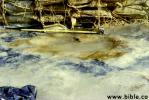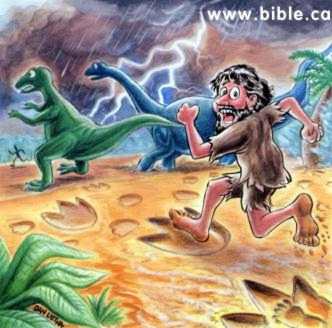
The Taylor Trail:
|
|
The Taylor Trail: |
Introduction:
The Taylor Trail Photo Gallery:
|
|
|
|
|
Thumbnail of Photo |
Track Number |
Description |
|
|
|
|
|
-3B |
This fossil footprint (-3B) is in the bed of the Paluxy River near Glen Rose, Texas. It is one of a 14 track sequence called the Taylor Trail. The tracks are consistently 11.5" in length with consistently alternating rights and lefts. They are among and, in this case, within dinosaur tracks.(Click on photo for high resolution) |
|
|
 |
-3B |
This print is one of the most spectacular in the sequence. When examined carefully a right human foot print can be seen in compelling detail, almost completely within a dinosaur foot print. Click on this picture to highlight the details of these two amazing prints.(Click on photo for high resolution) |
|
-3B |
Click here to see the outline of the dino track, then the outline of where the human stepped partially in the dino track. (Click on photo for high resolution) |
|
|
-3B |
Click here to see an outline imposed on a close up of the toes. |
|
|
-3B destroyed once for all time! |
-3B |
This is one of three tracks featured at the 1989 Dayton, TN creation conference that was destroyed the next day. On August 12, 1989 Dr. Don Patton spoke at a creation conference in Dayton, TN. He presented compelling evidence that both human and dinosaur tracks were present at the Taylor Trail, including the above pictures. Two well known evolutionists were present and at least one was conspicuously disturbed by this presentation. Both flew to Dallas the next morning and went immediately to the Paluxy River. It is reliably reported that they were in the river that afternoon with an "iron bar." Three days before they were in the river the footprint was observed looking like the picture above. Three days after they were in the river, it was observed looking like the picture left. (Clear photography was not possible till the water went down several months later, when this photograph was taken.) |
|
|
|
|
|
+6 |
Top view photo : The 1988 photograph on the left shows a very human-like fossil footprint in the bed of the Paluxy River near Glen Rose, Texas, well known for its dinosaur tracks. This left footprint is in a sequence of 14 that are left/right consistent and consistently about 11.5 inches in length. The tracks were excavated from beneath six feet of alternating layers of clay and limestone. The surrounding "mud push up" helps demonstrate authenticity.(Click on photo for high resolution) |
|
|
 |
+6 |
Excellent side view photo : By 1992 erosion revealed that this footprint was directly beside one of 134 dinosaur prints on the same platform. The entire trail of human-like tracks is among, within, across and, in this case, beside 25 inch dinosaur tracks.(Click on photo for high resolution) |
|
|
|
|
|
+5 |
The +5 fossil footprint as it appears in the bed of the Paluxy River near Glen Rose, Texas, famous for its dinosaur tracks. Dinosaur Valley State Park is near by. Here, the 11.5" human-like footprint is superimposed on the heel of a 25" dinosaur track. This right footprint (+5) is followed by a left (+6) which is also 11.5" in length. The right-left pattern is consistent throughout the entire sequence of fourteen 11.5" footprints known as the Taylor Trail (Click on photo for high resolution) |
|
|
+5 |
Here are two views of the +5 fossil footprint. You can see that it fits an actual human foot! (Click on photo for high resolution) |
|
|
|
|
|
|
 |
+3 |
This fossil footprint (+3) is one of fourteen that make up the Taylor Trail, a sequence of very human-like tracks found with at least 134 dinosaur tracks in the bed of the Paluxy river, near Glen Rose, Texas. The picture on the left shows the track when first excavated, about 1972. (Click on photo for high resolution) |
|
 |
+3 |
Sixteen years later erosion had removed a thin veneer of rock and revealed that the track was actually within a dinosaur track that was not visible initially. The dinosaur track is flush with the surface for the most part and slightly redder in color, indicating infill material. When viewed through the water, only the dinosaur track is obvious. (Click on photo for high resolution) |
|
 |
+3 |
However, when the water goes down, the human shaped depression can still be seen. (Click on photo for high resolution) |
|
|
|
|
|
+1 |
This cast was made by Stan Taylor in 1970. It appears to be an impression of one of the fossil footprints (+1) which make a 14 track sequence called the Taylor Trail, found in the bed of the Paluxy River near Glen Rose, Texas. The tracks are consistently 11.5" in length with consistently alternating rights and lefts. There are 134 dinosaur tracks on the same platform. (Click on photo for high resolution) |
|
|
+1 |
This picture of the +1 print, taken in 1988, shows the effect of 18 years of erosion which proceeds rather rapidly after the overlying layers are removed. A chunk has come out of the left side, but the same general shape is seen. (Click on photo for high resolution) |
|
|
+1 |
Prize Track +1 destroyed once for all time! This is one of three tracks featured at the 1989 Dayton, TN creation conference that was destroyed the next day. On August 12, 1989 Dr. Don Patton spoke at a creation conference in Dayton, TN. He presented compelling evidence that both human and dinosaur tracks were present at the Taylor Trail, including the above pictures. Two well known evolutionists were present and at least one was conspicuously disturbed by this presentation. Both flew to Dallas the next morning and went immediately to the Paluxy River. It is reliably reported that they were in the river that afternoon with an "iron bar." Three days before they were in the river the footprint was observed looking like the picture above, right. Three days after they were in the river, it was observed looking like the picture below, right. (Clear photography was not possible till the water went down several months later, when this photograph was taken.)(Click on photo for high resolution) |
|
|
|
|
|
 "We missed the boat!"
"We missed the boat!"
Taylor Trail Analysis:
By Don Patton Ph.D.
Perhaps the strongest feature of the evidence presented by the Taylor Trail is the fact that it is composed of a sequence of fourteen tracks, consistent in length, in a consistent right-left pattern. Each of the 14 tracks demonstrate, at least, a general oblong human-like shape.
They are amazingly consistent in length. The largest variance from the average is less than 5%. In the sequence of associated dinosaur tracks, length varies as much as 40%. Of course, some of them are still in the process of being "revealed" by erosion.
Individual toes can be discerned in seven of the fourteen tracks. Such detail is unexpected. In Mary Leakey's Laetoli tracks, one great toe can be distinguished but no individual small toes can be seen.
Left-right distinctions can be made in twelve of the fourteen tracks. Two are simply oblong shapes. When such determinations can be made, they are left-right consistent, with lefts where lefts should be and rights where rights should be.
A statistical analysis is represented in the following chart:
|
No. |
Human-Shape |
Length |
Toes |
Left-Right? |
L-R Consistent |
|
+6 |
|
11" |
|
L |
|
|
+5 |
|
11.5" |
|
R |
|
|
+4 |
|
11.5" |
|
? |
|
|
+3 |
|
11.75" |
|
R |
|
|
+2 |
|
11.75" |
0 |
L |
|
|
+1 |
|
11.75" |
|
R |
|
|
-1 |
|
11.5" |
0 |
L |
|
|
-2 |
|
11.5" |
|
R |
|
|
-3 |
|
11.5" |
0 |
L |
|
|
-3B |
|
11" |
|
R |
|
|
-3C |
|
11.75" |
? |
L |
|
|
-4 |
|
11.75" |
0 |
? |
|
|
-5 |
|
11.5" |
? |
L |
|
|
-6 |
|
11.75" |
0 |
R |
|
|
14 |
14 |
Av.11.53 |
7 |
12 |
14 |
The average distance between the tracks is 2.6 feet. If the individual's proportions were average, a height of 6' 4" would be indicated. For such an individual, an average distance between steps of 2.6' is completely normal. Actually, the distance begins about 2 1/2 feet and declines. At 3B (a standing track) he appears to stop. The heel of the next print is not as far ahead as the toes of 3B. From that point they begin to lengthen, indicating increasing speed. The greatest distance is between the last prints. With momentum increasing, the longer distances between these tracks is appropriate. When the tracks are dry is is easy for a person of average height to stride from print to print which has been demonstrated on a number of occasions.
Strength Of A Sequence:
|
|
But four faces are not! |
These readily understood examples illustrate the strength of a sequence in terms of evidence. It eliminates the idea of accidental resemblance by natural, unintelligent processes from the sphere of rational discussion. Fourteen tracks in a consistent right left pattern, consistent in length, including several amazingly detailed tracks with all five toes, instep and clearly defined heel, demonstrate conclusively that these tracks are not the product of natural erosion.